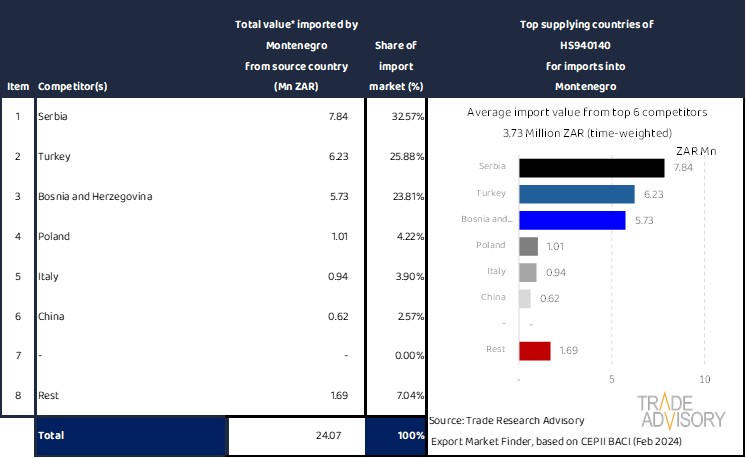COUNTRY
Montenegro
Seats: convertible into beds, other than garden seats or camping equipment
Context:
The results provided for this market and product combination is based on the analysis that underpins the outcomes of the study commissioned by SAFI (conducted in 2024). The study is based on Trade Advisory’s Export Market Finder international trade modelling platform that generates product-specific global market intelligence for exporters.
The approach identifies products and markets with export potential and opportunities for export diversification specifically from the global and export context of a particular ‘home market’ (in this instance South Africa), with the main container harbour as main port of exports for the market (in this instance the port of Durban). The approach makes use of a detailed set of various aspects of international trade (e.g. market economics, risk, import demand patterns, concentration, access in terms of tariffs and logistics as well as the home market’s existing as well as new potential export products) to describe the specific country and product combination. This approach is recognised by the World Trade Organisation (WTO) as a trade facilitation tool.
This report contains a summary snapshot of outcomes for the exports of HS940140 to Montenegro from the perspective of the home market (South Africa). More technical detail is available on request from Trade Research Advisory.
Angola positioned in terms of overall market opportunities
Evaluation
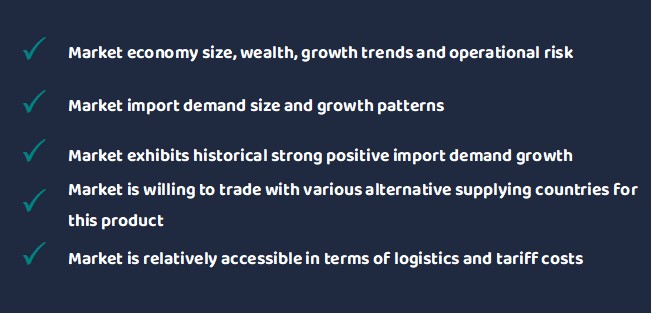

Realistic Export Opportunity
‘Untapped’ potential for this product into Montenegro is estimated at
3.73 Million ZAR
Import tariff applicable to this product into this market
N/A
The meaning of this…
Key Insights
Market import demand observations for this product:
Montenegro’s import demand shows that it is growing in both the short and long term, but relative to other global markets it is a small market. Montenegro exhibits an absolute positive growth trend for this product over the period under consideration, which contributes to confirming this market is a good choice from an import demand perspective.
Competition in the market for this product:
A market’s willingness to trade on a product with a variety of supplying countries is an indication that such a market may be more accessible to new alternative suppliers (such as from South Africa in this instance). Historical import patterns for Montenegro specifically demonstrate that Montenegro is trading with various alternative supplying countries for this product and hence this fact contributes to a more favourable evaluation of this opportunity from a market access perspective. However, Serbia is a significant supplier (at 32.6%), followed by Turkey (at 25.9%) and Bosnia and Herzegovina (at 23.8%) (see Competitors section for more details).
Access to market in terms of relative logistics and tariff costs
In relative terms, for this product, Montenegro is relatively accessible from South Africa in terms of the combination of logistics and tariff costs, compared to other markets for the same product. Montenegro’s import tariff level for this product from South Africa is set at 0.0% at the time of evaluation (the effective level may change in real-time and always needs to be confirmed before final decision making).
Market growth strategy for this product:
If a company’s strategy is to focus on relatively small but growing markets; Montenegro may be an ideal market to enter, understanding that larger volumes may only arise in future. This market may pose opportunity for smaller volume export producers.
Existing relationships with target market for this product:
South Africa to date has supplied none or relatively little of Montenegro’s import demand specifically for this product which means:
for mature exporters:
If an exporter is mature at exporting this product already, Montenegro may be an excellent opportunity to develop for the purposes of market diversification. It will however require some investment in terms of time, effort and costs to develop this market hitherto ‘untapped’ by South Africa’s exporters.
for less mature or new exporters:
If an exporter is mature at exporting this product already, Montenegro may be an excellent opportunity to develop for the purposes of market diversification. It will however require some investment in terms of time, effort and costs to develop this market hitherto ‘untapped’ by South Africa’s exporters.
South Africa – Montenegro trade for this product HS940140
Trends
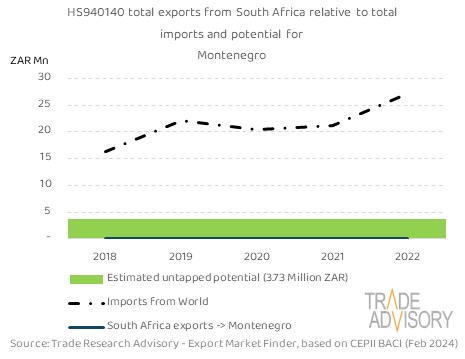
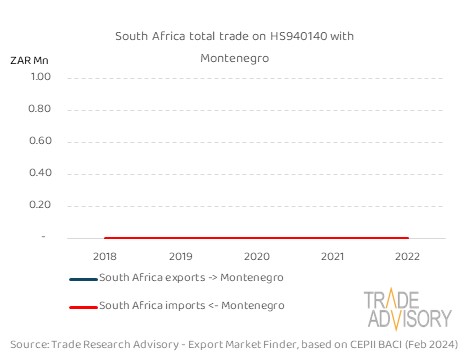
The first chart displays South Africa’s export value of the product (if South Africa historically did export this product to Montenegro) contrasted relative to the overall trend of this product’s import value (dashed brown line) into Montenegro over the last 5 years. The estimated ‘untapped’ potential for Montenegro (the solid green bar displayed in first chart) is also shown relative to the target market’s total imports (dashed brown line) as well as existing exports from South Africa(solid blue line). In this instance the estimated ‘untapped’ potential associated with this opportunity is estimated to be 3.73 Million ZAR. In the second chart the value of existing trade between South Africa and Montenegro are shown in finer resolution.
The share of South Africa’s exports of the specific product, relative to total imports of the same product into Montenegro from all other trading partners, is demonstrated in the bar chart (solid bars). South Africa supplies none of Montenegro’s total imports of this product (on a 5-year time-weighted basis). In this case, since South Africa is not a major existing supplier of this product into Montenegro, the opportunity to enter this market exists and most of the `untapped` potential market remains to be targeted by South Africa’s exporters.
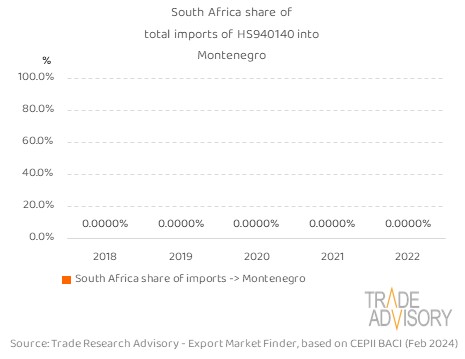
South Africa – Montenegro trade for this product HS940140
Competitors
While the preceding analysis indicated that Montenegro generally trades with a variety of supplying countries for this product, the following information provides more detail on the potential competing countries that currently are major suppliers of the product into Montenegro. South Africa, in recent times, does not appear in the existing supplier base of 37 countries serving this market’s existing import demand for this particular product (evaluated on a 5-year time-weighted basis). Note that South Africa is always placed in the last position of the chart (before ‘Rest’), irrespective of its actual position as supplier of this product into the target market, while only the main competitors are shown for context.
